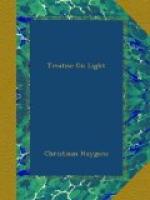As for the other method of division along the plane GHKL, it will be seen that each spheroid would have to detach itself from four of the neighbouring layer, two of which touch it on the flattened surfaces, and two at the edges. So that this division is likewise more difficult than that which is made parallel to one of the surfaces of the crystal; where, as we have said, each spheroid is detached from only three of the neighbouring layer: of which three there is one only which touches it on the flattened surface, and the other two at the edges only.
However, that which has made me know that in the crystal there are layers in this last fashion, is that in a piece weighing half a pound which I possess, one sees that it is split along its length, as is the above-mentioned prism by the plane GHKL; as appears by colours of the Iris extending throughout this whole plane although the two pieces still hold together. All this proves then that the composition of the crystal is such as we have stated. To which I again add this experiment; that if one passes a knife scraping along any one of the natural surfaces, and downwards as it were from the equilateral obtuse angle, that is to say from the apex of the pyramid, one finds it quite hard; but by scraping in the opposite sense an incision is easily made. This follows manifestly from the situation of the small spheroids; over which, in the first manner, the knife glides; but in the other manner it seizes them from beneath almost as if they were the scales of a fish.
I will not undertake to say anything touching the way in which so many corpuscles all equal and similar are generated, nor how they are set in such beautiful order; whether they are formed first and then assembled, or whether they arrange themselves thus in coming into being and as fast as they are produced, which seems to me more probable. To develop truths so recondite there would be needed a knowledge of nature much greater than that which we have. I will add only that these little spheroids could well contribute to form the spheroids of the waves of light, here above supposed, these as well as those being similarly situated, and with their axes parallel.
Calculations which have been supposed in this Chapter.




